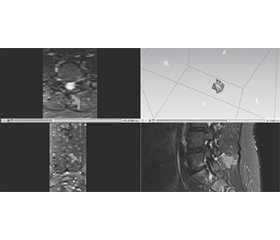Журнал «Травма» Том 25, №4, 2024
Вернуться к номеру
Клінічне порівняння односторонньої біпортальної ендоскопічної техніки з інтерламінарною мікродискектомією при однорівневій поперековій дискектомії: проспективне дослідження
Авторы: V.S. Balan (1), L.D. Kravchuk (2), I.V. Fishchenko (3)
(1) - Communal Non-Commercial Enterprise “Regional Clinical Hospital of Ivano-Frankivsk Regional Council”, Ivano-Frankivsk, Ukraine
(2) - National University of Ukraine on Physical Education and Sport, Kyiv, Ukraine
(3) - State Institution “Institute of Traumatology and Orthopaedics of the National Academy of Medical Sciences of Ukraine”, Kyiv, Ukraine
Рубрики: Травматология и ортопедия
Разделы: Клинические исследования
Версия для печати
Актуальність. Позитивні клінічні результати мікродискектомії коливаються в діапазоні від 75 до 80 %, однак частка незадовільних результатів при більш ніж дворічному спостереженні становить 38 %, а при восьмирічному сягає 40 %. З метою уникнення післяопераційного фіброзу, що в майбутньому може вимагати повторного хірургічного втручання, а також для покращення результатів хірургічного лікування гриж міжхребцевих дисків необхідно зменшити травматичність доступу. У цьому плані ендоскопічна поперекова дискектомія є найменш інвазивною технологією декомпресії та перспективним напрямком хірургічного лікування міжхребцевих гриж. Матеріали та методи. Проспективне дослідження проведено на базі нейрохірургічного відділення хребта та спинного мозку Івано-Франківської обласної клінічної лікарні. Критеріями міжгрупового розподілу були методи хірургічного лікування: хворим першої групи (n = 57) проведено видалення грижі міжхребцевого диска методом односторонньої біпортальної ендоскопічної диск-ектомії, хворим другої групи (n = 60) виконана відкрита інтерламінарна мікродискектомія. Результати. Вірогідних відмінностей при міжгруповому порівнянні за індексом інвалідизації Освестрі на всіх етапах не виявлено. Тривалість операції при використанні ендоскопічного доступу становила в середньому 41 хв [38,5; 44,75] проти 60 хв [57,5; 69,65] при мікродискектомії; різниця статистично значуща (р ≤ 0,01). При ендоскопічному доступі об’єм крововтрати був у 2,3 раза менше — 53,1 ± 19,7 мл та 121,5 ± 18,4 мл (р < 0,05). Як і очікувалось, тривалість перебування в стаціонарі була меншою в групі ендоскопічної диск-ектомії — 2 дні [1; 3] проти 4 діб [3; 6] у групі мікродискектомії (p ≤ 0,05), що асоціюється з ранньою активізацією пацієнтів, меншим больовим синдромом, відповідно меншим розміром післяопераційної рани та відсутністю необхідності догляду за раною. Висновки. Результати нашого дослідження показали потенційні переваги односторонньої біпортальної ендоскопічної дискектомії перед інтерламінарною мікродискектомією.
Background. Positive clinical outcomes of microdiscectomy vary in the range from 75 to 80 %. However, the share of unsatisfactory results with more than 2-year follow-up is 38 %, and with 8-year follow-up it reaches 40 %. To avoid postoperative fibrosis, which in the future may require repeated surgical intervention, and to improve the outcomes of surgical treatment for disc herniations, the traumatic approach is to be reduced. In this regard, endoscopic lumbar discectomy is the least invasive direct decompression technology and a promising direction of surgical treatment for herniated intervertebral discs. Materials and methods. A prospective study was conducted on the basis of the neurosurgery department of the spine and spinal cord of the Ivano-Frankivsk Regional Clinical Hospital. The criteria for intergroup distribution were the methods of surgical treatment: patients of the first group (n = 57) underwent removal of a herniated intervertebral disc by the method of unilateral biportal endoscopic discectomy, participants of the second group (n = 60) underwent open interlaminar microdiscectomy. Results. No significant differences were found in the intergroup comparison according to the Oswestry Disability Index at all stages. The duration of surgery when using endoscopic access averaged 41 minutes [38.5; 44.75] vs 60 min [57.5; 69.65] with microdiscectomy, the difference is statistically significant (р ≤ 0.01). The volume of blood loss was 2.3 times less during endoscopic access — 53.1 ± 19.7 ml and 121.5 ± 18.4 ml (р < 0.05). As expected, the length of stay in the hospital was shorter in the endoscopic discectomy group — 2 days [1; 3] versus 4 days [3; 6] in the microdiscectomy group (p ≤ 0.05), which is associated with early activation of patients, less pain syndrome, correspondingly smaller size of postoperative wound and no need for wound care. Conclusions. The results of our research showed the potential advantages of unilateral biportal endoscopic discectomy over interlaminar microdiscectomy.
одностороння біпортальна ендоскопія; інтерламінарна мікродискектомія
unilateral biportal endoscopy; interlaminar microdiscectomy

